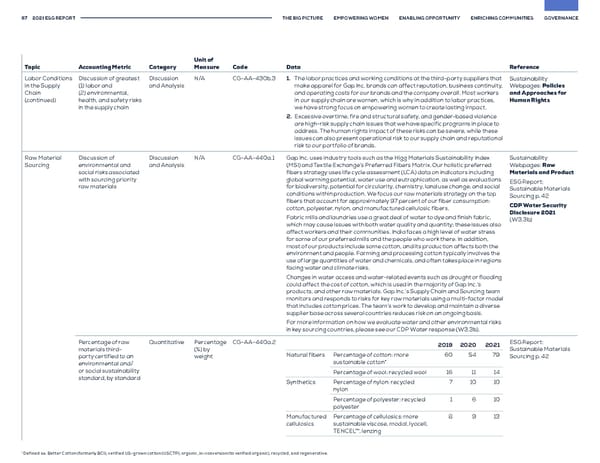67 2021 ESG REPORT THE BIG PICTURE EMPOWERING WOMEN ENABLING OPPORTUNITY ENRICHING COMMUNITIES GOVERNANCE Unit of Topic Accounting Metric Category Measure Code Data Reference Labor Conditions Discussion of greatest Discussion N/A CG-AA-430b.3 1. The labor practices and working conditions at the third-party suppliers that Sustainability in the Supply (1) labor and and Analysis make apparel for Gap Inc. brands can affect reputation, business continuity, Webpages: Policies Chain (2) environmental, and operating costs for our brands and the company overall. Most workers and Approaches for (continued) health, and safety risks in our supply chain are women, which is why in addition to labor practices, Human Rights in the supply chain we have strong focus on empowering women to create lasting impact. 2. Excessive overtime, fire and structural safety, and gender-based violence are high-risk supply chain issues that we have specific programs in place to address. The human rights impact of these risks can be severe, while these issues can also present operational risk to our supply chain and reputational risk to our portfolio of brands. Raw Material Discussion of Discussion N/A CG-AA-440a.1 Gap Inc. uses industry tools such as the Higg Materials Sustainability Index Sustainability Sourcing environmental and and Analysis (MSI) and Textile Exchange’s Preferred Fibers Matrix. Our holistic preferred Webpages: Raw social risks associated fibers strategy uses life cycle assessment (LCA) data on indicators including Materials and Product with sourcing priority global warming potential, water use and eutrophication, as well as evaluations ESG Report: raw materials for biodiversity, potential for circularity, chemistry, land use change, and social Sustainable Materials conditions within production. We focus our raw materials strategy on the top Sourcing p. 42 fibers that account for approximately 97 percent of our fiber consumption: CDP Water Security cotton, polyester, nylon, and manufactured cellulosic fibers. Disclosure 2021 Fabric mills and laundries use a great deal of water to dye and finish fabric, (W3.3b) which may cause issues with both water quality and quantity; these issues also affect workers and their communities. India faces a high level of water stress for some of our preferred mills and the people who work there. In addition, most of our products include some cotton, and its production affects both the environment and people. Farming and processing cotton typically involves the use of large quantities of water and chemicals, and often takes place in regions facing water and climate risks. Changes in water access and water-related events such as drought or flooding could affect the cost of cotton, which is used in the majority of Gap Inc.’s products, and other raw materials. Gap Inc.’s Supply Chain and Sourcing team monitors and responds to risks for key raw materials using a multi-factor model that includes cotton prices. The team’s work to develop and maintain a diverse supplier base across several countries reduces risk on an ongoing basis. For more information on how we evaluate water and other environmental risks in key sourcing countries, please see our CDP Water response (W3.3b). Percentage of raw Quantitative Percentage CG-AA-440a.2 2019 2020 2021 ESG Report: materials third- (%) by Sustainable Materials party certified to an weight Natural fibers Percentage of cotton: more 60 54 79 Sourcing p. 42 environmental and/ sustainable cotton* or social sustainability Percentage of wool: recycled wool 16 11 14 standard, by standard Synthetics Percentage of nylon: recycled 7 10 10 nylon Percentage of polyester: recycled 1 6 10 polyester Manufactured Percentage of cellulosics: more 8 9 13 cellulosics sustainable viscose, modal, lyocell, TENCEL™, lenzing *Defined as: Better Cotton (formerly BCI), verified US-grown cotton (USCTP), organic, in-conversion (to verified organic), recycled, and regenerative.
 GAP ESG Report Page 66 Page 68
GAP ESG Report Page 66 Page 68